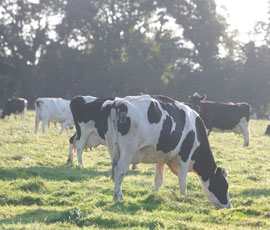Careful buffer feeding may be needed as cows get turned out

Maintaining high levels of dry matter intake (DMI) through turnout and into the grazing season is one of the biggest challenges facing dairy producers. With grazed grass alone incapable of supporting the high milk yields now being produced by many herds, carefully managed buffer feeding is the key to protecting production during this critical time.
The two biggest challenges at turnout are dry matter intake and grass quality, both of which can vary tremendously, explains KW nutritionist Dave Collett. “Given the level of control we now have over winter rations, it means that milk yields and quality tend to suffer unless grazing strategies are specifically designed around maintaining output.”
Not only does grass feed value vary during the grazing season, and even day-to-day depending upon sunshine levels, temperature and rainfall, but it’s also very easy to overestimate actual grass consumption. Combined with the effects of grazing management and the impact of the weather on grazing behaviour, it means that although it’s theoretically possible to achieve the results shown in Table 1 under ideal conditions, the reality for most producers is a maximum of maintenance plus 15-20 litres from grazed grass, even in the spring.
Table 1 – Theoretical performance with changing nutritional composition of grazed grass
|
|
|---|
“Grass is still the lowest-cost way to get nutrients into a cow, but it needs to be managed pro-actively, not re-actively, if intakes and performance are to be maintained,” Mr Collett continues. “And the best place to start is by accepting the limitations grass has.
“If spring grass has a dry matter content of 15%, even an intake of 15kg DM/cow equates to 100kg of fresh grass. That’s an extreme challenge for any cow.”
For early lactation or higher yielding cows producing 30-40 litres/day or more – and requiring 20-24kg/day DMI to support it – filling the resulting nutrient gap is essential if yields are to be protected. The problem is that any milk lost at this point in the lactation will be much harder, and more expensive, to regain later on.
For example, losing 2 litres/cow/day from mid lactation onwards through overestimating the nutrient supply from grazed grass could cut income by £1,700/month for a 100 cow herd. And that’s without considering the effect of poor fertility caused by any resulting excess body condition loss.
“Monitor cow condition closely through turnout, and take action to correct any problem before it’s too late,” advises Mr Collett. “Strategic use of grazing is often the best strategy, keeping early-lactation cows housed, or at least housed overnight, and concentrating grazing on those that have already been milking for five/six months.
“Treat grazed grass as supplementary to the rest of the ration rather than the other way around and be flexible – if the weather turns bad, for example, consider housing the cows until conditions improve. Monitor grass quality and growth carefully and graze down to a residual sward height of around 6cm to maximise both re-growth and milk production.”
Freshly calved and high yielding cows should also be re-housed onto full winter rations as soon as grass growth is limited: wait too long and cows will quickly enter negative energy balance, losing body condition, which will cause yield persistency and fertility to suffer.
“The key to success is to offer highly palatable buffer feed mixes to make up any shortfall – it will vary through the season, so adjust volumes regularly – and ensure cows have enough time to eat it. Either bring cows in early before afternoon milking, or consider using troughs or trailers placed in the field.
“Aim to balance the nutrients in grazed grass, which contains high levels of effective rumen degradable protein (ERDP), but low levels of the high quality rumen-bypass protein needed to support high yields. Levels of structural and digestible fibre are also low, both of which are important for rumen function, buffering against acidosis and promoting milk fat production.”
Table 2 shows two example rations for cows of different production levels, with a suitable mineral supplement containing higher levels of magnesium also important. Maize silage (high energy, low protein) is an ideal complement for high ERDP spring grass, with sugar beet feed and soya hulls good options to supply additional digestible fibre. Extra rumen-bypass protein is most cost-effectively supplied by dedicated supplements, such as rumen-protected soyabean meal and heat-treated rapemeal.
“Buffer feeding doesn’t have to be complicated, but it does have to be managed well,” Mr Collett states. “When it is, you’ll not only get the best out of your cows, but you’ll also get the best out of your grass, too.”
Table 2 – Buffer ration examples for cows at different yield levels (kg FW/head/day)
|
|---|
